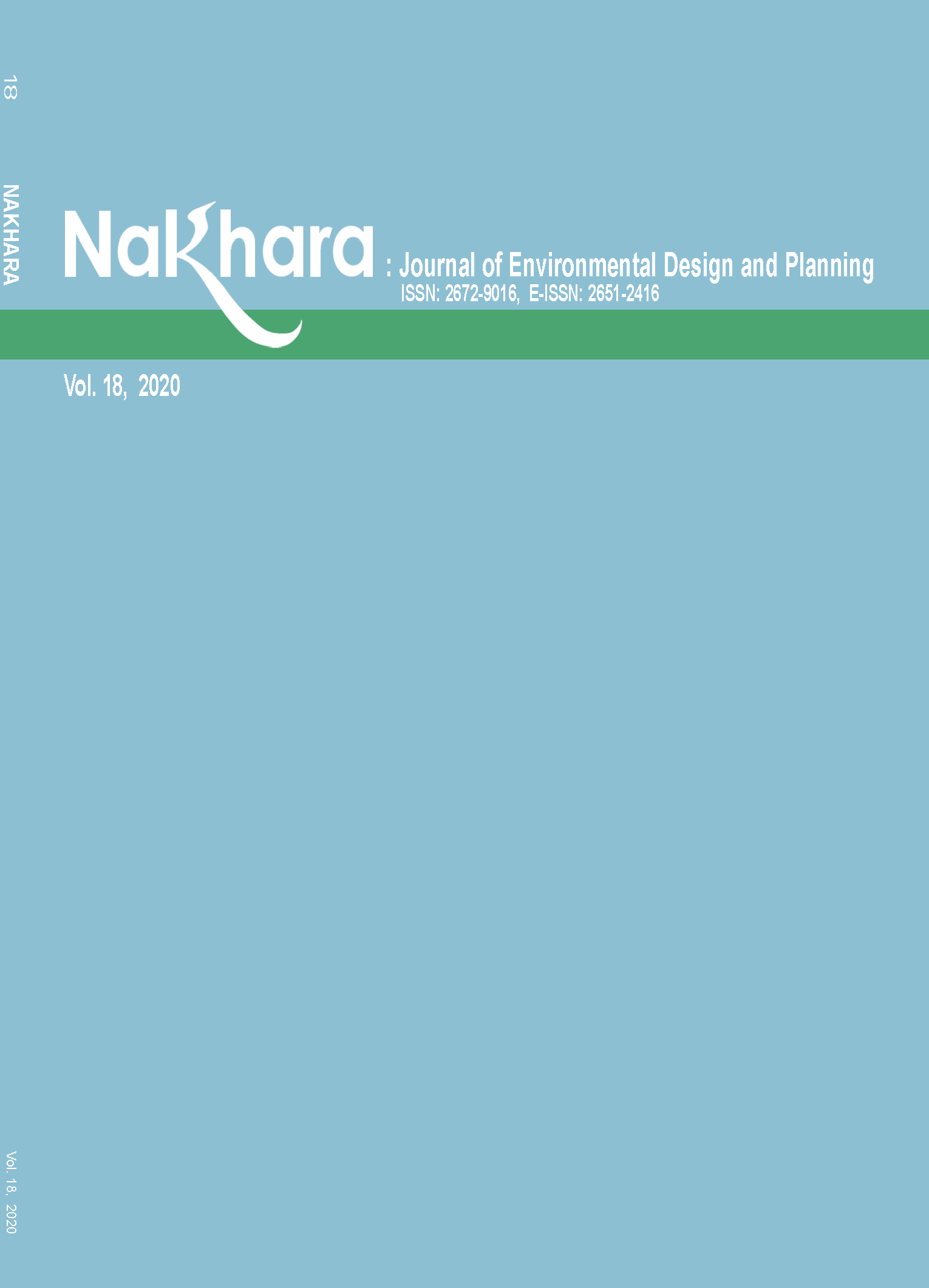An Investigation of a Modified Formula of Daylight Glare and Limiting Daylight Glare Indices in the Thai Elderly
Main Article Content
Abstract
Discomfort glare is perceived differently by the young and the elderly. However, the existing daylight glare formulae do not take the effects of age into account and the current limiting glare index was obtained from non-elderly subjects. To create lighting suitable for the Thai elderly, especially in terms of glare, two objectives were addressed. The first explored a modified formula of daylight glare for the Thai elderly, while the second investigated the limiting daylight glare index for the Thai elderly in particular areas of residential and public buildings. Both laboratory and field studies were undertaken. The former investigated a daylight glare formula modified for the effect of age of the Thai elderly. Experiments were carried out in a controlled chamber at Kasetsart University, Bangkok, Thailand. The latter explored the limiting daylight glare index for particular areas of residential and public buildings for the Thai elderly with studies conducted in the real environment. A modified formula was proposed to predict daylight glare for the Thai elderly. Limiting daylight glare indices for particular areas of both residential and public buildings for the Thai elderly were also proposed, and the recorded values were found to be higher than the existing limiting daylight glare indices.
Article Details

This work is licensed under a Creative Commons Attribution-NonCommercial-NoDerivatives 4.0 International License.
References
2. Akashi, Y., Muramatsu, R. & Kanaya, S. (1996). Unified glare rating (UGR) and subjective appraisal of discomfort glare. Lighting Research and Technology, 28, 199-206.
3. Bellia, L., Cesarano A., Iuliano, G.F. & Spada, G. (2008). Daylight glare: a review of discomfort indexes. Proceedings of Visual Quality and Energy Efficiency in Indoor Lighting: Today for Tomorrow, March 31, 2008, Rome, Italy, 1-10.
4. Bergamin, O., Choetzau, A., Sugimoto, K. & Zulauf, M. (1998). The influence of iris color on the pupillary light reflex. Graefe's Archive for Clinical and Experimental Ophthalmology, 236, 567-570.
5. Cai, H. & Chung, T. (2013). Evaluating discomfort glare from non-uniform electric light sources. Lighting Research and Technology, 45(3), 267-294.
6. Christoffersen, J. 2001. Monitoring procedures for the assessment of daylighting performance of buildings. A report of IEA SHC task 21 / ECBCS annex 29. Bruxelles: International Energy Agency, IEA.
7. CIBSE. (1997). LG 9: Lighting for Communal Residential Buildings. London: CIBSE.
8. Deremeik, J., Broman, A. T., Friedman, D., West, S. K., Massof, R., Park, W., Bandeen-Roche, K., Frick, K. & Munoz, B. (2007). Low vision Rehabilitation in a Nursing Home Population: The Seeing Study. Journal of Visual Impairment & Blindness, 101(11), 701-714.
9. Foster, R.G. & Kreitzman, L. (2004). Rhythms of Life: The Biological Clocks that Control the Daily Lives of Every Living Thing. London: Profile Books.
10. Hopkinson R.G. (1950). The multiple criterion technique of subjective appraisal. Quarterly Journal of Experimental Psychology, 2(3), 124-131.
11. Hopkinson, R G. (1972). Glare from daylighting in buildings. Applied Ergonomics, 3, 206-215.
12. IES. (1967). Technical Report No 10. Evaluation of Discomfort Glare: The IES Glare Index System for Artificial Lighting Installations. London: Illuminating Engineering Society.
13. IESNA. (2016). ANSI/IESNA Recommended Practice-28-2016 Lighting and the Visual Environment for Senior and Low Vision Population (Revised). New York: Illuminating Engineering Society of North America.
14. Kim W. & Koga Y. (2004). Effect of local background luminance on discomfort glare. Building and Environment, 38, 1435-1442.
15. Kim W., Ahn H.T. & Kim J.T. (2008). A first approach to discomfort glare in the presence of non-uniform luminance. Building and Environment, 43, 1953-1960.
16. Kuhn T., Wienold J. & Moosmann C. (2014). Daylight glare. Age effects and their impact on glare evaluation. Proceedings of the Energy Forum: Advanced Buildings Skins, Bressanone, October 28-29, 2014, Bressanone, Italy, 123-128.
17. Lizabeth, B. & Noell-Waggoner, E. (2003). Lighting: partner in quality care environments. (Online). Retrieved August 12, 2018 from https://www.pioneernetwork.net/wp-content/uploads/ 2016/10/Lighting-A-Partner-in-Quality-Care-EnvironmentsSymposium-Paper.pdf.
18. MacGowan D. & Clear R. (2013). Correspondence: discomfort glare. Lighting Research and Technology, 45(2), 258-260.
19. Pulpitlova, J. & Detkova P. (1993). Impact of the cultural and social background on the visual perception in living and working perception, Proceedings of the International Symposium: Design of Amenity, October 5-9, 1993, Fukuoka, 216-227.
20. Sato Y, Metoki N, Iwamoto J & Satoh K. (2003). Amelioration of osteoporosis and hypovitaminosis D by sunlight exposure in stroke patients. Neurology, 61(3), 338-42.
21. Tuaycharoen, N. (2006). The Reduction of Discomfort Glare by Interesting View (PhD thesis). University of Sheffield, Sheffield, UK.
22. Tuaycharoen, N. (2013). Thai Daylight Glare Index. Proceedings of Lux Pacifica 2013, March 6-8, 2013, Bangkok, Thailand, 203-208.
23. Van Den Berg., T.P.T.G, Uspeert, J.K., & Waard, De, P.W.T. (1991). Dependence of Intraocular Straylight on pigmentation and Light transmission through the ocular wall. Vision Research, 31(7), 1361-1367.
24. Velds, M. (2002). User acceptance studies to evaluate discomfort glare in daylit rooms. Solar Energy, 73, 95-103.
25. Völker, S. & Kistemann, P.T. (2011). The impact of blue space on human health and well-being – Salutogenetic health effects of inland surface waters: A review. International Journal of Hygiene and Environmental Health, 214 (6), 449-460.
26. Webb, A.R., Pilbeam, C., Hanafin, N. & Holick, M.F. (1990). An evaluation of the relative contributions of exposure to sunlight and of diet to the circulating concentrations of 25-hydroxyvitamin D in an elderly nursing home population in Boston. The American Journal of Clinical Nutrition, 51(6), 1075-1081.
27. White, M., Smith, A., Humphryes, K., Pahl, S., Snelling, D. & Depledge, M. (2010). Bluespace: the importance of water for preference, affect, and restorativeness ratings of natural and built scenes. Journal of Environmental Psychology, 30(4), 482-493.
28. Yonemura, G.T. (1981). Criteria for recommending lighting levels. Lighting Research and Technology, 13(3), 113-129.
29. Zaidi, F.H., Hull, J.T., Peirson, S.N., Wulff, K., Aeschbach, D., Gooley, J.J., Brainard, G.C., Gregory-Evans, K., Rizzo III, J.F., Czeisler, C.A., Foster, R.G., Moseley, M.J. & Lockley, S.W. (2007). Short-wavelength light sensitivity of circadian, pupillary and visual awareness in humans lacking an outer retina. Current Biology, 17, 2122-2128.

